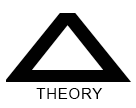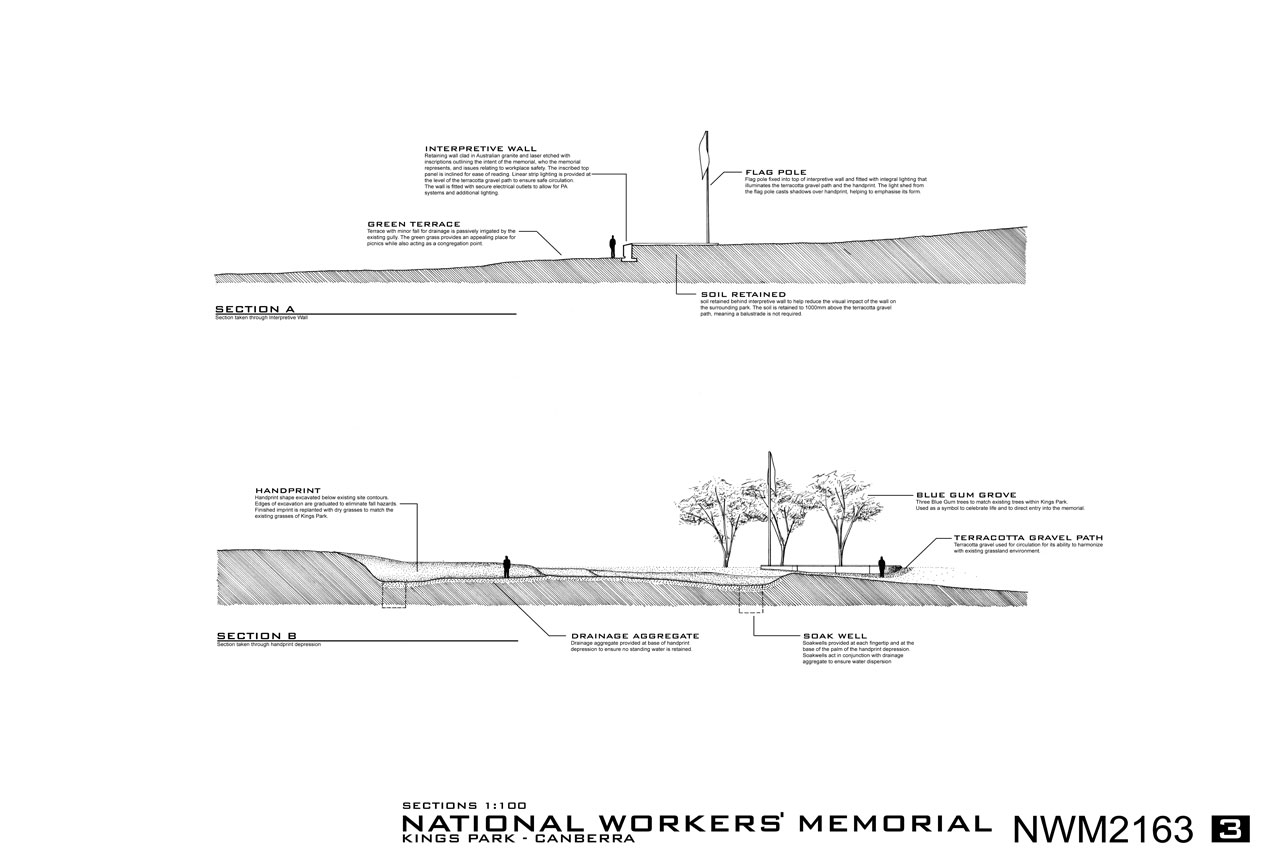






 |
| Tel: +61 423 601 604 - Email: architect@andrewtboyne.com |
 |
||
|
NATIONAL WORKERS MEMORIAL COMPETITION Canberra, Australian Capital Territory - 2011 |
||
|
This entry into the competition for the National Workers’ Memorial
Competition is comprised of
two key design elements: a large, interactive handprint excavated into
the existing landscape and an interpretive wall that functions as the
educational and commemorative component for the memorial. Visitors are
led to the memorial on a terracotta gravel path that provides initial
glimpses of the large imprint before leading them behind trees to the
semi-circular interpretive wall. As visitors proceed further along this
wall, the handprint reappears, enticing attendees to leave the gravel
path and walk within the large and symbolic imprint. For children and
adults, this element can be a fun, interactive and exciting element that
makes the memorial informal and celebratory. It can also be a place of
reflection, comfort and commemoration for Australians who have lost
loved ones to work related accidents. |
||
 |
||
|
The Handprint As a Humanising Image One of the main objectives of the National Workers’ Memorial is to recognise and pay tribute to the loss of human life in work related accidents. In a world of increased media coverage on war, hardships, and tragedy, it has become easy for society to dehumanise statistics on loss. By using an element of the human body as the focal point of the memorial, this design directly associates human life with the tragic statistics provided in the site’s interpretive panels. Such a connection will increase the effectiveness of the educational components of the memorial’s interpretative elements. It will also provide families who have lost a loved one a more personal and meaningful connection to the site. As a Lasting Imprint When you walk along the beach and find a footprint in the sand, it is a physical memory of someone that came before you. Even if you did not know that person, the sand has carried forth a physical reminder of that person from the past to the present for your reflection. Like footprints in the sand, memorials are physical reminders of something or someone that was once there and is no longer. The handprint incorporated in the proposed design acts as a physical reminder of Australian workers who have perished in work related accidents. While it can serve as a place of reflection and remembrance for all who have died at work throughout history, it can also represent the handprint of a specific individual for those who have experienced personal loss. As a Claim of Place For over 30,000 years, mankind has used the symbol of the handprint to define place. (National Geographic News, 2010) Hand stencils have been discovered on cave walls and geographic features throughout the world, including southern and eastern Australia. (Creative Spirits, 2011) By placing their hand upon a flat surface and blowing ochre pigments around it, Australian Aboriginals left a lasting imprint on the landscape that marked their territory and established a strong sense of place. (Creative Spirits, 2011) By sinking a handprint into the memorial site, Australian workers will have a defined sense of place within the nation’s capitol and within the nation’s conscience, effectively claiming a place for an often forgotten group of people. As a Representation of Workers The Australian workforce is comprised of a wide variety of individuals that possess extremely different skills and originate from a large number of social, cultural and economic backgrounds. Representing this diverse body of people as a collective whole is extremely challenging, as commonalities amongst them prove few and far between. One of the only characteristics that all Australian workers share is the use of their hands in moving the nation forward. It is this similarity that is represented in the enclosed design, as a handprint can be interpreted as a universal symbol for all workers: past, present and future. The Excavation/Depression of the Site By excavating a handprint into the existing site, the proposed design acknowledges that something is lost when an Australian worker dies on the job. While this depression is not meant to be sombre or disheartening, it is intended to be honest and educational about the tragedy that accompanies unnecessary deaths in the workplace. For visitors with no personal connection to workplace related deaths, the area and the depth of the handprint are impressive reminders of the thousands of Australian workers who have passed away on the job. For family members and friends of victims who already understand the enormity of such loss, the depression can be supportive and comforting, as they are embraced by the enclosure’s form in an intimate and unique space. Sinking the handprint design into the memorial site also properly represents the modest qualities of workers, Canberra and the Australian nation. While naturally beautiful and powerful, the memorial is not boisterous or dominating. |
||
 |
||
|
The Built Structures The Stone Wall In the proposed design, an Australian granite wall grows gradually out of and returns to the earth in a half circle that forms the base of a constructed hill. Visitors approach the wall on an accessible terracotta path that reflects the site’s Australian character. The wall begins at ground level and slowly grows to 1.2 metres tall as the visitor gets closer to the handprint impression. Halfway around the semicircular form, the wall appears to descend and disappear back into the ground. By building the wall into the base of this hill, any visual interference with the existing landscape is minimised and the heritage significance of the site is maintained (refer to Heritage Statement). Interpretive Panels Incorporated into the semicircular granite wall are eight interpretive panels inclined for easy reading. Each of these panels is laser etched with information and images that discuss workplace safety as a personal and collective experience that is a responsibility of all Australians. Because of their proximity to the ground (and the importance of disseminating safety information at a young age), information on the wall’s end panels will be catered to younger audiences who will attend the site with their families or in school groups. Information on the remaining panels will honour workers who have lost their lives while emphasising the importance of workplace safety to adult audiences. An aerial photograph of the handprint impression will also appear on one of the interpretive panels to give the audience greater visual perspective of the memorial. The Flagpole As visitors near the end of the granite wall and approach the increasingly recognisable handprint, they encounter a flagpole fixed into the top of the interpretive wall that is flying the Australian flag. While simple and seemingly presupposed, this flagpole is significant to the memorial’s design, as it emphasises not only the collective loss of the Australian nation but also the collective responsibility of the nation to prevent workplace related deaths. The Landscaping The proposed design seeks to maintain the visual impact and heritage significance of Kings Park’s open space. After the handprint impression is excavated and shaped, the site will be replanted with the dry grasses that differentiate Kings Park from other Canberra parklands. A terracotta gravel path will guide visitors from the car park to the granite wall, leading them past three Blue Gum trees planted on the land above the granite wall. These trees will act as both a directional guide and a symbol of life for viewers who are about to be exposed to important but solemn information about work related deaths. By maintaining its Australian feel, the memorial site will assist visitors in contextualising the loss of workers within a national framework. The proposed design also integrates a patch of green grass in front of the memorial wall that is passively irrigated by the gully that runs through the site. This “Green Terrace” is meant to act as a central meeting and gathering place for visitors to the memorial. |
||
 |
 |
 |
 |
 |